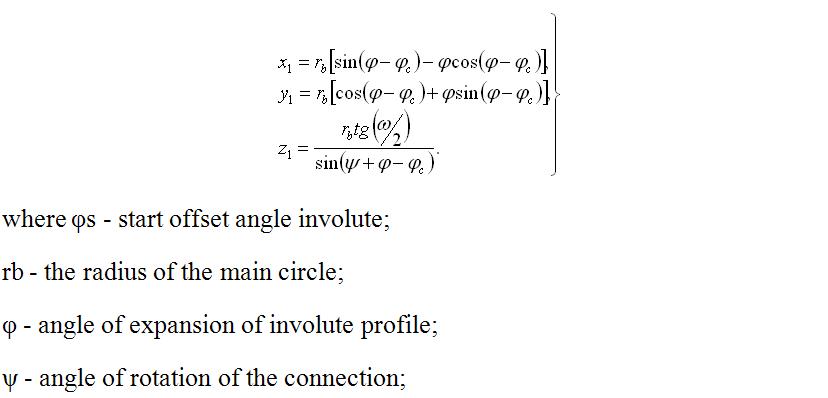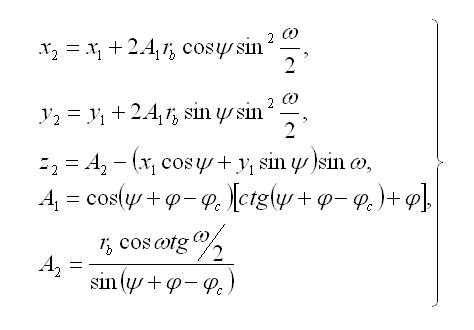

Gear couplings are widely used in modern engineering for combining the elements of the transmission of torque in a variety of mechanisms.
With the development of the technology becomes very important problem of improving the durability and reliability of machine parts, including gear couplings, in terms of economy of material and labor resources.
The current trend of increasing capacity and speeds of engines requires improving the design of gear couplings, the development of new technologies for their manufacture and the creation of best practice care, which will increase the service life of machines and plants.
Most of the failures of machines connected to the wear of the teeth of gear couplings, their breakage or an increase above the allowable limit of machine vibration caused by the gap increase in mesh sleeves.
It is known that in the process of gear couplings, in the presence of error mounting shaft, the load is perceived by a limited number of diametrically opposed teeth.
To solve this problem, increase the number of teeth of the transmission load by changing the design of the hub or clamp hub, reducing the width of the tooth bushes and increase the distance between the ring gear hub and the implementation of various types of spatial connections between the teeth and bushing holder.
Gear couplings are made primarily of structural steel reformable 45, having a low contact resistance. To improve the reliability and durability of gear couplings can be used more wear-resistant steel alloy, such as manganese, the use of surfactants and plastic processing and thermo-chemical treatment , sputtering deposition and more wear-resistant materials.
Great importance to the issue of reducing the wear of the teeth of gear couplings have the correct lubricant, which should minimize the formation of wear particles, thus reducing the abrasive wear. In addition, the lubricant should prevent the appearance of galvanic corrosion, and then seizing and jamming. The maximum effect is achieved through the use of oils with additives.
The aim of this work is to improve the bearing capacity and compensating gear couplings through the development process to ensure the process of forming tooth gear couplings bushings with solid geometry to the existing gear cutting equipment.
1. Analyze the existing geometry of the teeth sleeves gear couplings, gear couplings operating conditions and the technological methods of shaping the teeth sleeve facing.
2.Investigate the conditions for reaction of a compound ring and the sleeve teeth with rectilinear generator in the presence of errors mounting shafts.
3.Investigate the conditions for reacting a compound of cages, with the teeth with rectilinear generator and the sleeve longitudinally teeth modified in the presence of errors mounting shafts.
4.Develop a spatial geometry of the teeth, to approximate the spatial geometry, the resulting kinematic method that can compensate for errors mounting, changing the prescribed limits. Perform research conditions reacting a compound of clips and sleeves.
5.Develop a process to ensure manufacturing hub tooth couplings with the spatial geometry of an existing serial equipment.
Most of the work is devoted mainly constructive methods for improving the reliability and durability of gear couplings.
A study of studies of geometry, precision manufacturing and working conditions of gear couplings showed The recently published theoretical and experimental data on the distribution side of the gap in mesh sleeves allow for error in manufacturing and installation of the mating coupling shaft and allow with the necessary accuracy for engineering practice to use them in determining the load on the teeth. Developed engineering techniques can be used in further studies to develop methods to ensure longevity and forecasting gear couplings in general. Much less research is devoted to a topical issue with wear of the teeth in terms of forecasting durability of gear couplings [1, 2].
In [12] examined the possibility of improving the lateral surface of the teeth shape bushings and clips.
In [3] based on the studies, the dependence, which connects the rate of wear of the tooth with the pressure at the surface friction and sliding velocity.
This work is part of Master's studies that are conducted at the department, "Mechanical Engineering", Donetsk National Technical University.
At the department conducted research to develop and study methods for increasing longevity and durability of gear couplings [4, 5, 6], new construction gear couplings in order to reduce wear and their impact on the support shaft [7, 8],developed a new space-modified form of the tooth, allows the parameters to improve the contact of teeth in mesh sleeves and yoke sleeve [9].
In [10] discusses the technological methods to improve the durability of machine parts, in particular the influence of machining parameters on the wear resistance.
The kinds of wear gear couplings, depending on conditions [11].
Most electronic online resources devoted to issues of increasing wear resistance, in principle, all machine parts. Provides guidance on the selection of materials for moving parts in the design of friction, possible combinations. We consider the design options for the replacement of sliding friction bearings, that with respect to gear couplings difficult. Suggests ways to mount nodes, allowing to reduce the load during operation, a large number of sites contain recommendations for changing the properties of the lubricant. [13, 14].
At this stage of the Master of the alleged scientific novelty is:
The development of spatial geometry of the teeth, close to the spatial geometry obtained kinematic method, capable to compensate the error of installation, changing the prescribed limits while maintaining the contact line and load balancing in the compound and technological method of forming the ring gear teeth with the new geometry.
The most advanced measures to increase the carrying capacity and compensating gear couplings - is making the teeth with various types of spatial geometry on the lateral surface of the teeth sleeve. Formed with the lateral surface of the tooth geometry provides increased contact area during operation, leading to a simultaneous increase in the carrying capacity and compensating gear couplings.
A prerequisite for increasing the carrying capacity and compensating gear couplings to adjust for the adverse effects inevitably arise through the implementation of assembly defects in the process of cutting gears actual conditions of their operation. That is, use the second method of Olivier, the basic principles are:
- Implementation of the processing products of the conditions under which it will operate;
- The use of the tool (at least in the last stage of processing), identical with the details of the mating workpiece.
Getting the spatial geometry of the teeth bushings needed to compensate for all errors of assembly and manufacture of the teeth is difficult due to lack of equipment capable of fully re-create the necessary movement of workpiece and tool. The result is that have developed different versions of geometry of the teeth close to the space [16, 17, 18, 19].
Proposed in [19], spatial geometry, obtained as the envelope of the family of the side surfaces of the tooth produces slats, obtained by setting the hub of all the provisions relative to cage taking place in real-mesh clutch. In this family the lateral surfaces of the tooth is a two-parameter generating rack where the first parameter angle of rotation relative to rail hub, and the second parameter angle of rotation of the coupling relative to the initial position of the conditional. The main advantage of this modification is to provide a spatial uniform distribution of load between the teeth in the sleeve, without the expense of theoretical shameful engagement.
In [15, 20, 21] describes a gear coupling, consisting of a cage with internal teeth with rectilinear generator and hub with teeth on the side of which feature spatial geometry, the resulting kinematic method. In this case the contact line on the surface of the tooth holder are described by the equations:

The coordinates of contact points on the surface of the tooth sleeve defined by the system of equations:

Designed and manufactured in accordance with the recommendations of [20, 21] toothed coupling can be used to connect the misaligned shaft heavy-duty mechanism with tilt angles greater than 45 '. This increases the load capacity of the coupling by increasing the ratio of overlap and increase the contact of the teeth. However, when the conditions for which the connection of the teeth and yoke bushings was calculated, that is when the real skew angle in the compound, there may be point-to-marginal-contact between two diametrically opposite pairs of teeth, thus reducing the load capacity of the teeth.
One of the ways to improve the design of gear couplings is to create a connection between the tooth holder with straight teeth and a generator hub with spatial geometry, which can compensate for any existing installation errors that vary within specified limits. In this case, regardless of the magnitude of errors occurring in an interval of values stored linear contact of the teeth and even distribution of load between them within the zone of contact.
Implementation of the proposed connection to reduce to 1.75 times the level of bending stresses due to uniform distribution of gaps and to ensure contact of all teeth in the zone of contact, regardless of the angle of tilt from the specified range of values. As well as reducing the level of contact stresses on the teeth due to the exclusion of the point nature of the contact line and provide tooth contact. Reducing the level of contact and bending stresses on the teeth in general lead to increased durability of gear couplings.
Development of a new spatial geometry can compensate for errors mounting, varying within the set limits, leads to the need for modernization of existing technological methods of processing gears or develop new ones. Outlined in the recommendations for the development of technological support will allow design and engineering processes for tooth sleeve gear couplings spatial geometries, capable of mounting shafts compensate the error, changing the prescribed limits. At the same time cutting teeth you want to perform on an existing standard equipment standard cutting tool.
The results obtained can be used for machine-building enterprises, as well as in research and development organizations in the design and manufacture of spur gears.